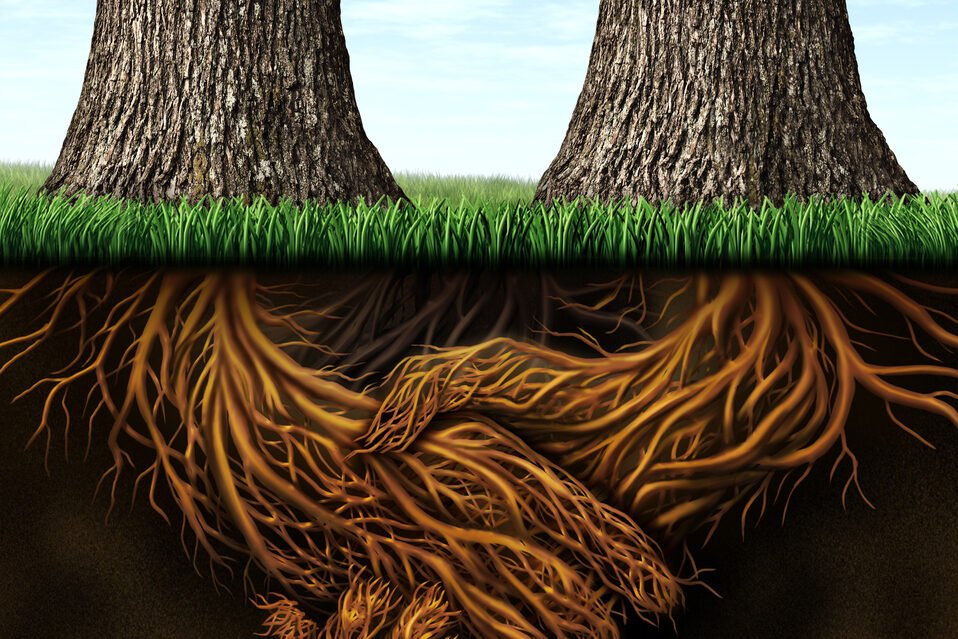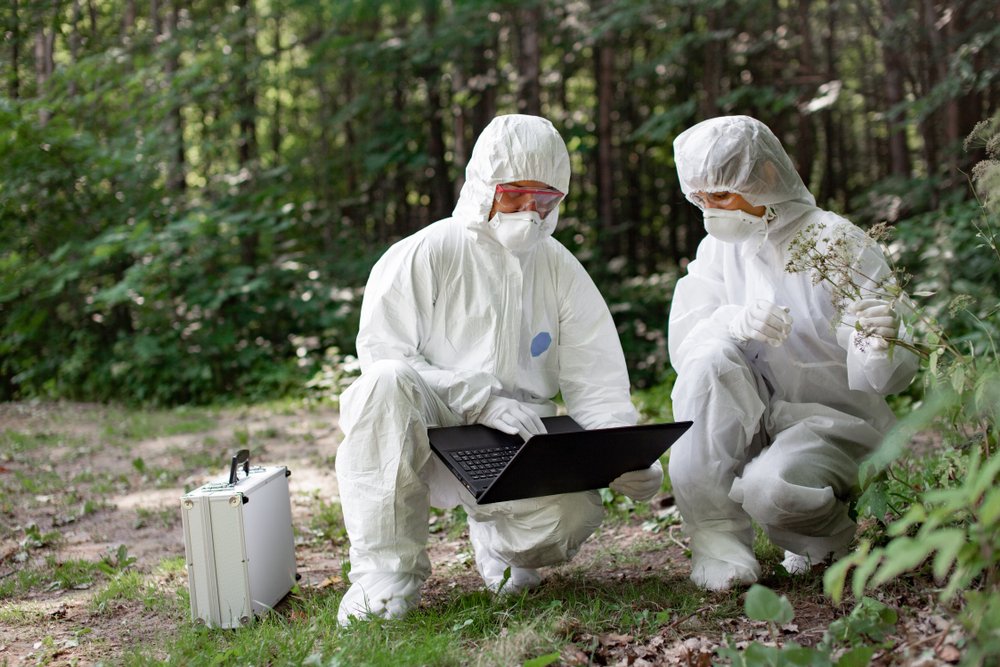Trees Use Fungi as Their Secret Messaging System

It sounds like the beginning of a fairy tale, but it is true, trees talk to each other using a vast underground network of fungi. Scientists have discovered that the roots of trees are connected by thin threads of fungi called mycorrhizae. These fungal networks create something that researchers often refer to as the “Wood Wide Web,” a living system that links plants together and allows them to share information and resources.
Instead of shouting across the forest, trees use these fungal highways to send chemical signals. They can warn each other about insect attacks, share nutrients, and even send distress signals when they are sick. Experts explain that the fungi benefit too, receiving sugars and nutrients from the trees in exchange for their communication services. It is a beautiful, mutualistic relationship that has been quietly operating beneath our feet for millions of years, hidden from view but vital to the survival of forests around the world.
Trees Share Nutrients with Their Neighbors
When we think of nature, we often imagine it as a ruthless competition for resources. But trees turn that idea upside down. In the underground world of root networks and fungi, trees actually share food with each other. Older, stronger trees can send sugars and nutrients through the network to help feed younger seedlings or trees that are struggling due to illness or poor growing conditions.
Forest ecologists point out that this nutrient-sharing is especially important in places where conditions are harsh. A tree that gets plenty of sunlight might help out a shaded neighbor that is struggling to survive. In a very real sense, trees look after each other, ensuring the survival of the larger community. It is a quiet, compassionate system where the success of one tree can strengthen the entire forest. Nature, it turns out, has a lot more teamwork built into it than we often realize.
Warning Signals Can Travel Across the Forest
Imagine if you could warn your neighbors about a break-in just by sending a signal through the ground. That is exactly what trees do when they sense danger. When a tree is attacked by insects or disease, it can release chemical signals into the network, alerting nearby trees to prepare their defenses.
Plant scientists explain that after receiving a warning, neighboring trees may start to produce bitter chemicals in their leaves to make themselves less tasty to invaders. They might also thicken their bark or trigger other protective mechanisms. This early warning system gives trees a better chance of surviving threats that could otherwise wipe out large parts of a forest. It is an incredible example of communication and cooperation among plants, showing that even silent organisms can be highly social when their survival is on the line.
Mother Trees Play a Special Role in Forests
Not all trees are created equal when it comes to underground communication. Researchers have found that older, larger trees, sometimes called “mother trees,” serve as central hubs in the underground network. They are deeply connected to many other trees and often act as the main providers of resources and information within a forest.
Mother trees have vast root systems and strong fungal connections, allowing them to reach and support hundreds of younger trees. They can recognize their own seedlings and are even more generous in sharing nutrients with them. Ecologists suggest that losing these ancient giants can weaken the entire network, making the forest more vulnerable to disease, drought, and other stresses. Mother trees are not just towering figures in the landscape. They are also caretakers, mentors, and essential leaders in the hidden life of the forest.
Fungi Are the Unsung Heroes Behind the Scenes
While trees often get the spotlight, the fungi that connect them are the real masterminds behind underground communication. These tiny organisms form symbiotic relationships with trees, penetrating their roots and extending far into the soil to create massive interconnected networks. Without fungi, the secret conversations of the forest would not be possible.
Mycologists — scientists who study fungi — emphasize that these organisms are more than just passive messengers. They actively manage the flow of nutrients and help maintain the balance of the entire ecosystem. They can even favor certain tree species over others, shaping the composition of the forest over time. By linking trees into a vast living network, fungi create a resilient system that can respond to challenges, heal damage, and adapt to changing conditions. It is a silent, invisible partnership that keeps forests healthy and thriving.
Tree Communication Helps Forests Heal Faster

Forests are incredibly resilient places, and part of that strength comes from the underground communication between trees. When a forest suffers damage from storms, fires, or human activity, the connected root and fungal networks help coordinate the healing process. Trees can share resources to support injured neighbors, and chemical signals can trigger regrowth and defense mechanisms across the forest floor.
Ecologists who study forest recovery have observed that areas with intact fungal networks tend to bounce back faster from disasters than those where the networks are broken. This hidden web of life acts like an emergency response system, distributing help where it is needed most. It is a moving reminder that in nature, survival is not just about individual strength. It is about connection, collaboration, and the deep, silent bonds that tie living beings together.
Trees Can Recognize Their Own Kin
It is mind-blowing to think that trees might recognize their own relatives, but research suggests that they can. Through the underground network of roots and fungi, trees seem to be able to distinguish between their own offspring and unrelated neighbors. This recognition affects how resources like nutrients and water are shared across the network.
Plant ecologists have observed that mother trees tend to prioritize their own seedlings, sending them more carbon and nutrients than they send to unrelated saplings. This favoritism makes evolutionary sense, as helping related trees thrive ensures that a tree’s genetic legacy continues. It challenges the way we usually think about plants — as passive beings disconnected from the dramas of life. Instead, trees are tuned into their communities in ways that show a surprising level of social complexity and care, even if it happens far below the surface where we rarely look.
Stressed Trees Send Out Distress Calls
When trees experience stress from drought, disease, or physical damage, they do not just suffer silently. They send out chemical distress signals through their roots and fungal networks, alerting their neighbors to the trouble they are facing. These distress calls can trigger nearby trees to bolster their defenses or even prepare to endure the same stressors.
Scientists studying this behavior believe it gives forests a better chance of survival when large-scale threats strike. A single wounded tree might suffer, but its early warning can protect hundreds of others. This system of distress signaling shows how deeply intertwined forest life really is. Trees are not isolated organisms, each fighting for its own survival. They are members of an ancient, highly coordinated society where mutual aid increases the chances that the forest as a whole will endure tough times.
Communication Networks Can Be Disrupted
Although the underground communication network between trees is remarkably resilient, it is not invincible. Human activities like logging, road building, and heavy machinery use can damage the delicate root systems and fungal threads that keep the forest connected. When these networks are severed, trees become isolated and less able to support each other.
Forest ecologists warn that without their underground connections, trees are more vulnerable to pests, diseases, and climate stress. Recovery after disturbances like storms or fires becomes slower and less effective. Protecting the hidden web of life below the forest floor is just as important as preserving the trees above it. Understanding how interconnected trees really are helps shift our thinking from seeing a forest as a collection of individual plants to seeing it as a living, breathing community — one where every connection matters.
Different Species Can Communicate Across the Network
Another fascinating discovery is that it is not just trees of the same species that communicate underground. Different species of trees, and even other plants like shrubs, can be connected through the same fungal networks. This means that entire ecosystems are woven together into a complex web of sharing and signaling.
Researchers have found that an older birch tree, for example, can send nutrients to a younger Douglas fir through the fungal network, especially when the fir is shaded and struggling. These cross-species collaborations show that the forest is not just about competition. It is about cooperation and mutual support across different kinds of life. The fungal network does not seem to discriminate much between species as long as the relationships are beneficial. It paints a picture of nature that is far more communal, generous, and interconnected than many of us ever imagined.
Forest Networks Are Ancient Survival Strategies
The ability of trees to communicate and cooperate underground is not a new phenomenon. Scientists believe these networks have been around for hundreds of millions of years, evolving as one of nature’s most successful survival strategies. Early plants that formed partnerships with fungi were better able to access nutrients and survive harsh conditions, setting the stage for the lush forests we know today.
This ancient system has helped forests adapt to everything from ice ages to droughts to changing climates. It highlights the idea that cooperation, not just competition, is a driving force in evolution. Trees did not just survive by standing alone. They thrived by building hidden alliances and creating vast networks of support. In every handful of soil, in every stretch of ancient roots, lies a story of resilience and connection that stretches back almost to the dawn of life on land.
Scientists Are Learning How to Protect These Hidden Networks

Understanding how trees talk to each other underground is changing how we think about forest conservation. Protecting forests now means more than just saving individual trees. It means safeguarding the entire invisible communication system beneath the soil.
Forestry experts are beginning to rethink logging practices, land management, and reforestation efforts to preserve these critical fungal networks. Planting trees without considering how they connect underground can create isolated individuals instead of strong, resilient communities. Meanwhile, maintaining intact old-growth forests, where the networks are richest and most developed, is seen as essential for the health of the planet. As science uncovers more about these hidden conversations among trees, it reminds us that life is interconnected in ways we are only just beginning to understand and that protecting one thread helps preserve the strength of the entire web.
